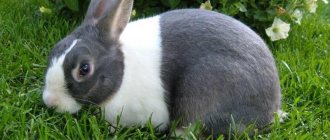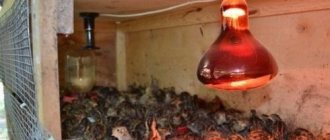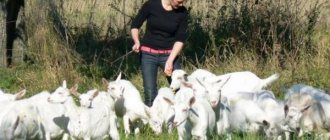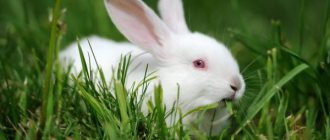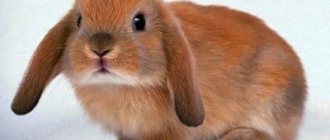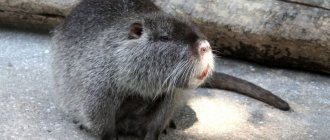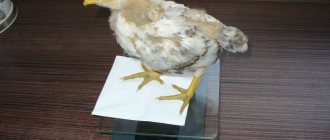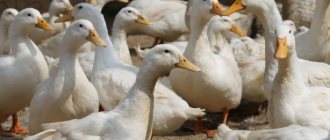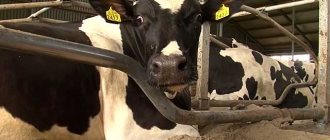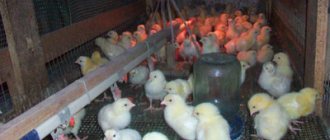Among decorative rabbits, the colored dwarf is one of the most common breeds. For example, at the 2000 exhibition in Austria, almost three hundred of these babies were presented. And it wasn’t just their cute appearance that brought them great popularity. This animal is ideal for small apartments, requires minimal care, and has an easy-going disposition. But, nevertheless, before buying such a baby, you should familiarize yourself in detail with the characteristics of this breed and the nuances of keeping the animal.
Description of the Colored Dwarf breed
This short-haired dwarf rabbit will be loved not only by children, but also by adult family members. A little miracle called a colored dwarf comes in a wide variety of colors.
Here is a list of some of them:
- Siamese;
- blue;
- chinchilla;
- black;
- grey;
- fiery;
- squirrel;
- hotot;
- Havana;
- Japanese;
- Russian;
- Dutch;
- "ren";
- Thuringian;
- white-awned;
- silver;
- luxury;
- red.
One of the most popular colors among fans is oto. This is a white rabbit with a beautiful black spot around the eyes. The spot must be of the correct shape.
Buying a future family member
What should you pay attention to when purchasing a dwarf rabbit? First of all, look at the animal’s eyes and nose; if they are clean and have no obvious damage, then this is a sign of good health and strong immunity of the baby. Also examine the ears. For rabbits, they should be clean and without scratches; if the furry ones suddenly scratch them, this may indicate the appearance of a mite. These animals can be of very different colors: white, brown, black, gray or spotted.
Rabbits are very susceptible to weather changes. They do not like stuffiness, heat and cold. The ideal indoor temperature for a baby rabbit is + 18-21 degrees. In the place where the cage is located, drafts should not be allowed.
When letting your pet out for a walk, do not forget to close the windows and doors so that there are no drafts and your pet does not have the opportunity to escape.
Origin of the breed
The animals appeared in 1938 by crossing a Hermelin and an outbred rabbit by the German rabbit breeder Hoffmann. In 1957, there were more than 20 coat colors of this breed.
There are two main versions. The first says that it was bred in Holland, and a wild rabbit and red-eyed representatives of the Polish breed were taken as the starting material for it. This happened between 1920 and 1930.
The second theory says that all the credit for breeding colored decorative rabbits belongs to the German breeder Hoffmann. It is believed that he bred the first representatives of the breed line in 1938 by crossing the Hermelina with an animal without a clear breed affiliation.
Appearance of the breed
Dwarf decorative rabbits appeared in Great Britain around the 70s of the last century. Initially, the breed was called Polish, but after 30 years German colleagues joined in the breeding, creating a white-haired breed with two eye colors - red or blue. Another 30 years later, Dutch breeders became interested in the dwarf breed, and colored dwarf rabbits saw the light of day. Ten years later, in 1940, the Dutch breed standard was adopted.
The Second World War almost completely wiped out the Dutch breed; by the end of the war, only 17 dwarf rabbits were counted, but thanks to British caring breeders and the well-known love of rabbits, the breed was restored in a short time.
Standard
The name “colored dwarf” speaks for itself: The maximum permissible figure is 1.5 kg.
The European document prescribes the desired weight in the range of 1.1-1.25 kg. The minimum value cannot fall below 0.8 kg.
The body of rabbits of the Colored Dwarf breed is stocky and cylindrical in shape. The front legs are short. The tail is small, tightly fitting to the body. Females do not have dewlaps. The head is large and short. The coat has a good shine. The ears of such pets are raised straight up.
Main breeds
The existing gradation divides decorative dwarf rabbits depending on the length of their coat into:
- short-haired - 1.5-2 cm;
- medium-haired - 2-4 cm;
- long-haired - from 5 cm.
The most common breeds of dwarf rabbits among breeders and hobbyists are:
- Angora rabbit. Belongs to long-haired breeds. Harmonious, strong body with good bones. Weight ranges from 1-1.6 kg. The head is round, the ears are erect. According to the breed standard, they should be exactly 6 cm long. The fur is very long (up to 20 cm), soft and fluffy. Due to its long hair, the animal looks like a fluffy ball of fur. Requires careful care and regular brushing. The character is complex and quick-tempered, especially if the rodent is not purebred.
- Rabbit Hermelin. This breed was developed at the beginning of the last century by crossing a wild white albino with a silver and a Dutch rabbit. Due to its resemblance to the fur of an ermine, it is also called the ermine rabbit. It has a large head, small ears (about 6 cm) and blue or red eyes. The ideal weight for them is 1.3 kg. The coat is white, short and dense. Their character is quite complex and capricious. Their average lifespan is 6-7 years.
- Colored dwarf rabbit. It was developed on the basis of Hermelin in the 20s. last century. The body is miniature, strong with short legs, the back part is larger. The head is round, with a short neck and large eyes. The ears stand straight and are 5-6 cm long. There are a wide variety of colors: yellow, Siamese, lilac, fiery red, black, red and many others. Weight 0.6-1.4 kg. They are calm and friendly in nature, but there are also unbalanced specimens. With proper care, he lives 5-6 years.
- Dwarf fold ram. Indeed, it is somewhat similar to a small lamb with long (20-27 cm) hanging ears. The ears do not droop immediately, only closer to a month. A baby rabbit is born with normal erect ears. The characteristic hump between the large eyes gives it a resemblance to a ram. The coat is of medium length. The color varies (from black to white). It has a stocky body with strong short legs. Slightly larger than other breeds. The weight sometimes reaches 3 kg. This dwarf rabbit has a peaceful and docile character. He is sincerely attached to his owner and can respond to his nickname. An ideal companion for small children. Can live up to 8-10 years.
- Dwarf Rex. This is a short-haired dwarf rabbit, bred as a result of selection by French breeders. It has very pleasant to the touch, beautiful and smooth fur, similar in quality to chinchilla fur. But in appearance the rodent looks like a beaver due to its red-brown color. A characteristic feature of this breed is short, crooked and underdeveloped whiskers. The body is long, with a pointed head. The ears are not very long and stand straight. The average dwarf rabbit weighs 1.5 kg. His disposition is very phlegmatic, calm and balanced. They live up to 7 years and even longer.
- Lion headed mini rabbit. The breed was born in Belgium and received its name due to its resemblance to the mane of a lion. The fur around the muzzle is much longer than on the body. The body is stocky and dense, weighing up to 1-1.6 kg. The ears are erect, the paws are small but strong. Fur color is very diverse. The character is good, not aggressive, but rabbits really don’t like having their ears pulled.
There are many different breeds of domestic dwarf rabbits, and they are all very different.
Character traits
The character of this rodent directly depends on how it is treated. If the animal is not scared, loved, often picked up and caressed, then it will respond in kind. When a rabbit is having a good life, why would it be aggressive?
Important! You should especially carefully monitor such living creatures during the period close to puberty. At this time, animals often behave restlessly and even aggressively. Such aggression can manifest itself both towards other eared animals and towards humans. The pet achieves complete calm only by the age of 1.5 years.
Dwarf rabbits are attractive not only by their appearance, but also by their friendliness. Fluffies get used to their owners in record time and quickly remember their own name. You simply don’t want to keep such a cute little animal in a cage continuously, so many owners prefer to let their pet walk around the house for a long time. The toilet problem is easily solved - it is no more difficult to train a colored miniature rabbit to use a litter tray than a kitten.
Short-haired dwarf rabbit - a friend in taste and color
It is not always possible to have a dog or a cat, but you really want to have a soft and warm creature nearby.
In this case, the rabbit is perhaps ideal.
A cozy and flexible animal will bring a lot of pleasure. Moreover, caring for it is simple and the costs are low.
These animals are small in size, they do not need a bulky cage, you can afford to have them in any, even small apartment.
Read also: Feed yeast: what is it, what is it made from, why and how to give it to cows
There are several breeds of such babies, and among them is a tiny miracle - a short-haired colored dwarf rabbit .
Conditions of detention
Rabbits, as animals with a well-developed nervous system, are susceptible to stress. It arises as a result of sharply changing external conditions. Such changing conditions are: a transition from one diet to another, a sharp change in daily routine, a prolonged absence of water or food, human control of nests when the cubs are there, a bright flash of light in the dark, catching rabbits in an enclosure and other sudden influences that cause stress.
An unsatisfactory microclimate in the room where rabbits are kept also contributes to the development of stress. Lack of sufficient ventilation leads to the accumulation of harmful gases and dust in the air, which is also one of these causes of stress, and can result in respiratory paralysis and death of the animal.
Requirements for the cage - its dimensions must be 5 times larger than the dimensions of the rabbit. If several animals are kept in one enclosure, then 6-7 per individual. The rods are metal, without varnish or paint. The house is located in a place protected from direct sunlight and drafts. There should be bedding on the floor of the cage. This can be sawdust, straw, or special granules that absorb moisture.
Colored rabbits do not tolerate heat above +25C and easily catch colds in frosts below -18C. In open sun, the enclosure or cage should be shaded and cooled with cold water bottles or ice packs wrapped in a cotton towel.
In cases where the animal has freedom of movement around the house, it is necessary to hide all wooden products, wires, documents from it, and cover the furniture legs with something. Rabbits are constantly growing teeth, and in an attempt to wear them down, they will chew on anything they can get their hands on. But if desired, the baby can be weaned from this.
Rabbit in an enclosure
The enclosure is installed in a corner where enough light comes in, but not under the window itself. Direct sunlight is harmful to the rabbit. They enclose it with a net, and be sure to attach a door to let the pet out for a walk. The floor is covered with a rug; dwarf rabbits are not allowed to sit on plastic or laminate.
The smallest dwarf rabbit from the USA, registered in the Guinness Book of Records, weighed only 400 g. Although a female weighing 297 g now lives in Chelyabinsk and her owners have applied for the record.
The rabbit's enclosure should not be in a place that is too dry or windy.
Rules of maintenance and care
With proper care, rabbits of this breed can live up to 12 years. Before purchasing a pet, you should purchase a cage suitable for keeping it. It may not be too big, but it should be wide enough so that the animal does not feel cramped. The bottom needs to be covered with bedding. The following are suitable:
- sawdust;
- straw;
- special granules that absorb moisture.
Along with the cage, it is advisable to purchase a special house where the animal will hide if it gets scared or wants to rest. You can use a box or drawer with a hole as a house. The cage must be placed in a place where there are no drafts or direct sunlight, but enough fresh air and light. You definitely need a tray for the toilet, which is placed in a secluded place.
Both the cage and litter tray need to be cleaned regularly. Dirt causes dangerous diseases in animals, promotes the appearance of parasites and an unpleasant odor. The bedding should be changed once a week, and the grates and surfaces should be washed thoroughly. Once or twice a month you need to disinfect the cage, house and tray with a solution of potassium permanganate or chlorhexedine.
The rabbit loves to play and move, so it needs to be let out of the cage from time to time. At the same time, it is necessary to ensure that he does not chew wires and furniture. It is best to ensure that potentially dangerous items are hidden or locked in advance. You can pamper your pet with a purchased or sewn hammock, or fence off a special play area for him.
If the dimensions of your home allow it, it is better to purchase an aviary instead of a cage. The rabbit can not only live in it, but also move freely and safely.
The feeder should be heavy enough that the rabbit cannot tip it over. At the pet store you can purchase a drip-type feeder and sippy cup that are attached to the cage.
It is convenient to feed a rabbit with special dry food, which already contains the necessary minerals and vitamins. However, your pet's diet should also include fresh vegetables and grass. Rabbits also need twigs of willow, birch and maple, which rabbits can use to grind down their ever-growing incisors.
Have you tried giving your rabbit branches?
Giving your rabbit too many root vegetables and greens can cause digestive upset. The basis of a rabbit's diet should be hay. You should add mineral supplements to your food, such as:
- mineral stone;
- bone meal;
- pressed chalk.
In addition, the animal is prohibited from giving any sweets, potatoes, ready-made human food, bread and pasta made from premium flour.
Important! Sometimes rabbits begin to eat their droppings. There is no need to be afraid of this, this is a need of the animal’s body. Litter reduces the rate of digestion by 20%, thereby increasing the digestibility of food. Moreover, for a rabbit it is a unique source of vitamins.
The rabbit itself also needs to be looked after. Pet hygiene includes:
- weekly examination of the ears, eyes, nose, anus and genitals;
- monitoring the condition of teeth;
- trimming nails using a nail clipper 1-2 times a month;
- weekly combing of fur.
You should not bathe your rabbit unless absolutely necessary. These animals are quite capable of cleaning themselves. You can wash it if it gets very dirty and cannot clean itself.
ATTENTION! If there is any strange behavior in your pet, it is best to show it to a veterinarian.
It is better to buy baby rabbits in nurseries
Feeding
This little one is very modest in nutrition. The basis of the diet is hay, ready-made grain mixtures and drinking water. Fresh vegetables and fruits are used as top dressing - carrots, apples, cabbage, beets, lettuce and fresh herbs.
Rabbits must be given clean, settled and filtered water at a temperature of +15...+18 degrees. It is poured into dropper drinking bowls - plastic bottles with a metal spout.
For dwarf rabbits, pet stores offer many types of different mixtures and granular feeds. The advantage of this option is that the daily norms of microelements and nutrients have already been calculated. It is enough to give food according to the dosage from the package and do not forget about water. In addition, industrial mixtures are enriched with minerals and vitamins. You don't need to buy them separately.
Diseases
The disease can occur due to poor nutrition. Namely, the diet of rabbits should not include:
- chocolate;
- cookies;
- food from your table;
- potato;
- drops and “honey sticks”;
- bread and flour products.
Preparing to buy an animal
We will immediately warn you against a common mistake - first prepare the apartment for buying a rabbit, and only then go shopping, and not vice versa. Preparation includes:
- Purchasing a cage;
- Purchase of feed;
- If possible, hide the wires, as the pet loves to chew on them.
Purchasing a cage
First, choose a comfortable cage.
Cage for dwarf rabbit
The material of the rods should only be metal; they will quickly chew through plastic or wood. Although the cage can be rearranged, it will still have a favorite place determined by you, and this place should not be sunny, and there should be no drafts. Rabbits cannot tolerate stuffiness, they do not have sweat glands, and if direct sunlight hits the cage, it can kill them.
The bottom of the cage should be covered with hay, also attach a feeder, a drinking bowl, and a small house where the pet could hide from annoying looks. Rabbits love to make noise, kicking everything that is not attached, especially in the early morning. Place a litter tray in the corner of the cage, which must be washed after use. The animal will not go dirty a second time, but will do business nearby. Plus, if you clean on time, there will be no unpleasant odors; the decorative rabbit is very clean.
Rabbit food
Their main diet is hay.
It is very important to choose only high quality hay, do it responsibly!
Rabbits have a weak stomach, intestinal upset and diarrhea are a common occurrence for these animals if they are not given proper food and care.
Ready-made rabbit food – grass pellets
You can also buy ready-made rabbit food fortified with vitamins and minerals in pet stores.
In the summer, you will need to add fresh grass, dandelions, plantain, and yarrow to your diet. Rabbits enjoy eating apples, cabbage, carrots and beets with less pleasure.
Among the treats, you can note raw potatoes (only without eyes and peels) and cobs of dry corn, but these products should be given only in limited quantities, as a reward for training.
Care
In general, colored miniature fluffies have strong natural immunity. To keep your pet healthy, it is enough to get all the necessary vaccines against pasteurellosis, hemorrhagic disease and myxomatosis. and control the quality of his diet.
Be sure to include mineral supplements in your diet. Calcium is very important for rabbits. When it is deficient, dangerous symptoms such as convulsions, heart failure appear, and small rabbits can even die from this.
You should especially carefully monitor such living creatures during the period close to puberty. At this time, animals often behave restlessly and even aggressively. Such aggression can manifest itself both towards other eared animals and towards humans. The pet achieves complete calm only by the age of 1.5 years.
Description and standards
According to the current breed standard, the weight of an adult animal cannot exceed 1250 g. For home keeping without the purpose of breeding, the permissible weight of an adult is 1.5 kg.
- the body of the animal is short, tightly built;
- tarsi short, well pubescent;
- the head is round, small, set on a short neck;
- The ears are rounded, no more than 5.5 cm long, straight, pressed to each other.
The eyes are large, dark, expressive. In appearance, the rodent resembles a cute plush toy with short thick fur.
The short-haired dwarf rabbit can have any color characteristic of other breeds. The following colors are popular and loved:
- Havana, luxury;
- Russian (ermine), Siamese;
- fiery black, chocolate;
- blue marder;
- squirrel;
- silver, blue, fawn;
- piebald, butterfly.
In colored rabbits, pure white coat color is rare and is highly valued by animal lovers.
Purchase
Buying colored dwarf rabbits has some difficulties. For example, they are very easy to confuse with baby rabbits of larger breeds. If you give in to your emotions and buy a representative of the dwarf line from the first seller you come across, in a couple of months you will receive an animal of impressive size. To avoid this, you should choose a seller of purebred dwarf rabbits very carefully.
Therefore, it is better to purchase this pet in specialized nurseries or from private breeders, at fairs and through advertisements. For example:
- Krol Arthur - St. Petersburg;
- Les lapins MarSi – Moscow.
The price depends on color, nursery and other factors. You should buy a baby no earlier than one month of age. Such a little rabbit will weigh only about 200 grams; as it grows, it will not only grow larger, but will also change a little - its muzzle will elongate a little, its forehead will become wider, its ears will be longer.
When choosing a purchase, follow these rules:
- It is advisable to make a purchase in specialized nurseries, and not in regular pet stores.
- The rabbit must be active, constantly on the move. The coat and eyes are shiny.
- You should carefully examine the eyes, nose, and anus for any discharge. If they are present, the animal is unhealthy.
- It is definitely worth checking the condition of the animal’s skin. To do this, pick him up and gently run your finger against the pet’s fur, looking for places of damage and the presence of parasites.
- To determine the character of the animal and whether it is accustomed to being handled, you can pick it up and hold it for a while, constantly stroking it. Calm individuals will not break out.
Content
And finally, a tiny fluffy miracle has settled in your home. Now he needs to create the most comfortable living conditions possible.
First of all, the rabbit needs a good, spacious cage from which he cannot leave on his own. In the cage you need to arrange a shelter , a house where the frightened animal will hide, rest, and just sleep.
There should be bedding . This can be sawdust, straw, or special granules that absorb moisture.
The rabbit uses a certain place for the toilet; you can put a small tray , which needs to be washed frequently.
It is better to choose a calm, quiet place for the cage, without bright lighting.
Feeding
- The main food that a rabbit, including the dwarf colored one, needs is hay . It is sold in pet stores, but, of course, prepared with your own hands, it is much better and more nutritious.
The hay should always lie in the cage, in a special feeder, so that the animal cannot scatter it and get it dirty. - In summer, the short-haired dwarf needs to be given green food : he willingly eats various cereals, leaves of dandelion, plantain, quinoa, bloodroot and burdock.
Branches of deciduous trees - willow, maple, birch - are constantly needed by the rabbit .
Mandatory condition: the greens must be clean, collected away from major highways. In addition, you should not feed grass that is wet from rain.
In addition, dwarfs willingly gnaw carrots, lettuce and cabbage.
- Many rabbit breeders feed their pets concentrated food , the choice of which is impressive on sale.
- The animal should always have clean water.
Diseases
Our little pets, unfortunately, are susceptible to various diseases.
The owner of the animal must take care of timely vaccination of the rabbit - this will help avoid the animal’s illness and death.
If a rabbit spends a lot of time in its house, eats poorly, is reluctant to move, has a depressed appearance, dull fur, watery eyes, and indigestion, this is a reason to immediately contact a veterinarian.
Do not self-medicate your animal - sometimes minutes count. Only in a veterinary clinic will he receive the necessary help.
Upbringing
How nice it is to have a rabbit at home!
But you can admire the animal not only in a cage.
He should be allowed to run around the room, having first removed all the wires, so as not to be surprised later why the TV and computer do not work after a rabbit walk.
It’s good to take your favorite “bunny” with you to the dacha or take him for a walk in the park . There are special leashes and harnesses for walking. The animal quickly gets used to it and willingly jumps on the grass. In addition, during a walk the rabbit has the opportunity to dig in the ground. In a cage he is deprived of this.
Under no circumstances should you leave your pet unattended either in the room or outside.
Short-haired colored rabbits are quite easy to train . By working with your pet regularly, you can teach him some simple actions - serve on his hind legs, jump over an obstacle, even bring a toy between his teeth. When choosing tricks, you must proceed from the nature of the animal and its preferences.
Colored dwarf - owner reviews
Anastasia B. I wouldn’t have gotten a rabbit myself, I wouldn’t have even thought about it, but my brother gave me this little miracle. At first I was afraid that they wouldn’t get along with the cat, but to my surprise they have been living together for three months now. It's easy to feed a rabbit - hay, food, carrots, apples, he loves everything. She even loves cabbage, but I read that it’s better not to give it.
Irina M. They gave me a rabbit for Christmas. Very active, but a coward - afraid of strangers. There were no problems with litter box training; the principle is similar to training cats or dogs.
Breeds of decorative rabbits
It’s easy to get confused when choosing such pets. The fact is that there are a lot of breeds of decorative rabbits. They are all very beautiful and sweet . I want to buy them all at once. But a novice rabbit breeder should focus not on beauty, but on the characteristics of the breed and conditions of detention.
The following breeds of decorative rabbits are considered the most popular and easiest to keep at home:
These are not all the popular breeds of decorative rabbits. The list above shows the animals that are easiest to purchase in Russia .
How many years do dwarf rabbits live at home?
Decorative or dwarf rabbits are animals that are used as a favorite pet. A characteristic feature of this breed remains its constant dwarf size. Each breed of dwarf individuals requires special attention and care. If you provide comfortable conditions for normal living, these animals will delight you with their activity and attractive appearance. In the article we will talk about how long dwarf rabbits live.
What bloating looks like in rabbits is indicated in this article.
Differences between dwarf, decorative and miniature rabbits
Domestic rabbits are decorative, dwarf or miniature. When purchasing, few people think about the difference between the concepts; at first glance, they are equivalent. Meanwhile, substituting a category can lead to an incident in the future. As a result of confusion, the animal may grow unexpectedly larger or smaller than desired.
| Photo | Category | Characteristic |
| Decorative Flemish giant | Decorative rabbits | This category includes all breeds with beautiful colors, in which meat and fluff are not the main purpose of breeding. This even includes the Californian and Flemish giants, that is, breeds with a medium or large body size. |
| Pygmy hare | Dwarf rabbits | They have body sizes like industrial and decorative rabbits. The only difference is the shortened legs. Due to their small legs, dwarf individuals appear smaller. The category contains both meat and decorative breeds. |
| Miniature rabbit | Miniature rabbits | Decorative and dwarf breeds weighing up to 3 kg. Initially they were bred only for home keeping as pets. |
Since species often overlap, it is worth studying the breeds you like in advance. Rabbits that combine all three categories are best suited for keeping as a pet. For simplicity, they are often called simply dwarf, but the characteristics must be mixed.
Feeding - what food can be given
What do they eat? The diet of ornamental rabbits is based on dry, fresh hay. If your pet is not happy with such food, then you can soften it with salt water. Also, the rabbit’s body should be replenished with vitamins obtained from fresh tree branches. In this case, you can use birch, rowan, raspberry, apple tree, linden.
You can see what the Gray Giant rabbit looks like from this article.
The store also has a ready-made compound feed for rabbits, developed for each breed of ornamental species. It is very useful to give animals grain crops, such as barley, legumes, and oats.
The diet of ornamental rabbits should include the following succulent foods:
- boiled potatoes,
- apples,
- turnip,
- carrot,
- young corn on the cob,
- beet,
- cabbage.
It is forbidden to give red cabbage. Rabbits should be given food in small portions. Any food that the rabbit does not eat must be immediately removed from the cage.
Buying a rabbit
So, you have prepared everything you need, now you need to choose where to buy your treasured rabbit. This can be either a pet store or a dwarf rabbit nursery. Of course, in the nursery the price will be slightly higher, but there all the animals are vaccinated, guaranteed not to be sick, and always well-groomed.
Rabbit from the nursery
Our dwarf rabbit is not that expensive, the price in a pet store starts from 1000 rubles, in a nursery - from 1500. But in the latter they will professionally tell you how to care for him, what to feed him, how to prevent illness, and in general you can call there for consultation and later.
Dwarf rabbit exploring the apartment
First of all, after purchase, the rabbit should carefully examine the entire apartment. If he is very scared, then put your pet in a cage for a couple of hours, let him stop shaking. Then just open the cage door and hide, the rabbit will become bolder and go out to explore the territory.
The rabbit climbed onto the table
The main thing at this time is not to scare the animal; it is generally better to hide and watch from around the corner. If you frighten him, he can hide so much in the corner behind the sofa that it will be difficult to get him out. But this is not so scary - for example, a chinchilla can even die from fright. Over time, after a couple of days, when he gets comfortable and gets used to his new owners, he can be picked up.
Attention! If you already have a dog or cat at home, then most likely they will have conflicts!
That’s all, the baby’s future life depends on your attitude towards him; if you surround him with love and care, then he will delight you for many years!
And remember - we are responsible for those we have tamed!
